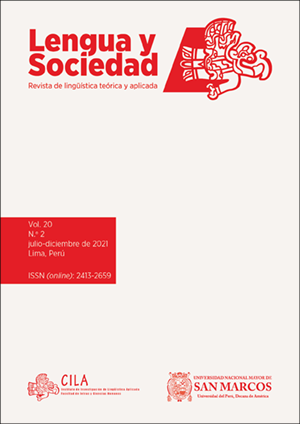Attributive and locative states: a cognitive semantic study of characterization in Lima Spanish
DOI:
https://doi.org/10.15381/lengsoc.v20i2.22243Keywords:
caracterização, estados, domínios conceptuais, janela atencional, Lima EspanholAbstract
Attributive states relate entities of the world to properties. In Spanish, they are expressed, in syntax, as projections of verb phrases structured by copulative or semicopulative verbs, as adjective nuclei and phrases, prepositional phrases, nominal phrases and relative constructions as their complements. At the cognitive level, these semantic-syntactic structures fulfill the same function: the characterization of world objects by a conceptualizer. The aim of this paper is to explain this cognitive process in Spanish by describing its semantic-syntactic structures and their use. For this purpose, a sample of 117 sentences collected through a survey of 31 university students was used. The analysis was carried out according to the postulates of the formal semantics of Moreno Cabrera, 2003; Chafe, 1970; and the cognitive semantics of Talmy, 2000; Fillmore, 1985; and Langacker, 1999. The results of the research show that, from syntax, characterization is most frequently expressed with adjective phrases, and to a lesser degree with prepositional phrases, participles and relative constructions. In terms of usage, attribution is expressed differently in women and men. Thus, women used more attributes to characterize the entities and paid more attention to the conceptual domain of the physical, such as the shape and color of skin and hair, age and attitude. Males, on the other hand, used more eventive characterization and attributions related to the posture of the characterized entity.
References
Chafe, W. (1970). Meaning and the structure of language. University of Chicago.
Demonte, V. (1979). Semántica y sintaxis de las construcciones con ‘ser’ y ‘estar’. Revista española de lingüística, 9(1), 133-172. http://www.sel.edu.es/pdf/ene-jun-79/demonte%2079.pdf
Fillmore, Ch. (1985). Frames and the semantics of understanding, Quaderni di Semantica, 6, 222-254. http://www.icsi.berkeley.edu/pubs/ai/framesand85.pdf
Maldondado, R. (2012). Gramática cognitiva. En Ibarretxe-Antuñano, I., y Valenzuela, J. (Eds.) Lingüística cognitiva (pp. 213-247). Anthropos.
Katz, J., & Fodor, J. (1963). The structure of a semantic theory. Language, 39, 170-210. https://bit.ly/3vZSFFi
Langacker, R. (1999). Grammar and conceptualization. Mouton de Gruyter.
Leech, G. (1977). Semántica. Alianza Editorial.
Lyons, J. (1997). Semántica lingüística. Una introducción. Editorial Paidós.
Moreno Cabrera, J. (1998). Sintaxis formal y sintaxis conceptual: más allá de la tipología de las oraciones de relativo. Syntaxis 1, 63-92. http://rabida.uhu.es/dspace/handle/10272/3194
Moreno Cabrera, J. (2003). Semántica y gramática: sucesos, papeles semánticos y relaciones sintácticas. A. Machado Libros S. A.
Montague, R. (1974). Gramática Universal. En R. Montague Ensayos de Filosofía Formal (pp. 158-182). Alianza Editorial
Otaola Olano, C. (2004). Lexicología y semántica léxica. Teoría y aplicación a la lengua española. Ediciones Académicas.
Real Academia Española. (2010). Nueva gramática de la lengua española. Manual. Espasa Libros.
Rivera, M. E. (2001). Percepción y significado del color en diferentes grupos sociales. Inv. Univ. Mult, 3, 74-83. https://dialnet.unirioja.es/descarga/articulo/3684094.pdf
Serrano, M. J. (2008). El rol de la variable sexo o género en sociolingüística: ¿diferencia,dominio o interacción? Boletín de Filología, XLIII, 175-192. https://ultimadecada.uchile.cl/index.php/BDF/article/view/18049
Talmy, L. (2000). Toward a cognitive semantics. Volume 1. Concept structuring systems. Massachusetts Institute of Technology.
Downloads
Published
Issue
Section
License
Copyright (c) 2021 Verónica Lazo García

This work is licensed under a Creative Commons Attribution 4.0 International License.
AUTHORS RETAIN THEIR RIGHTS
a. Authors retain their trade mark rights and patent, and also on any process or procedure described in the article.
b. Authors can submit to the journal Lengua y Sociedad, papers disseminated as pre-print in repositories. This should be made known in the cover letter.
c. Authors retain their right to share, copy, distribute, perform and publicly communicate their article (eg, to place their article in an institutional repository or publish it in a book), with an acknowledgment of its initial publication in the journal Lengua y Sociedad.
d. Authors retain theirs right to make a subsequent publication of their work, to use the article or any part thereof (eg a compilation of his papers, lecture notes, thesis, or a book), always indicating its initial publication in the journal Lengua y Sociedad (the originator of the work, journal, volume, number and date).



























